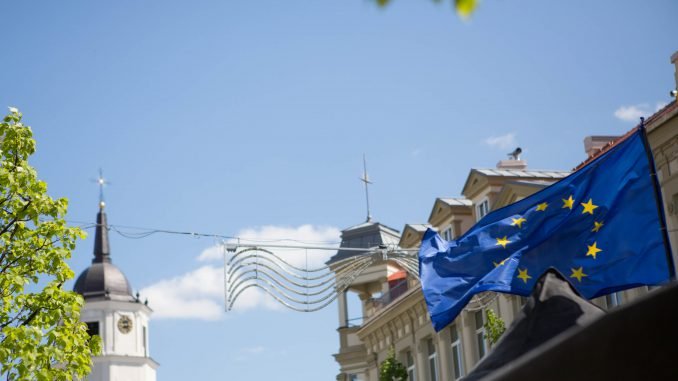
The latest data about Lithuania’s GDP growth could be a warning about what is in store for the country once the European Union‘s 2014-2020 financial period ends.
“Last period’s funds have already been used up, and those of the new period are not yet in use. We can see a drop in investment, which is why GDP growth [in the second quarter of 2016] was only 2%, while it could have been 3%,” Mauricas, the chief economist of Nordea bank, says.
However, there is no reason to dramatize the end of the EU money bonanza, he adds, saying there is a silver lining.
“We should not expect a big shock and there’s some good to be gained in the long run, since this will force both companies and government institutions to think how to operate more efficiently,” he says.
EU money already distributed
Over the decade since 2004, when Lithuania joined the European Union, its GDP doubled and was almost €35 billion in 2014. Over this period, Lithuania received 4.5 times more money than it paid into the EU budget.
In the EU’s 2014-2020 financial period, €12.88 billion has been set aside for Lithuania. This is equivalent to €4,375 per person or €625 per person per year.
Klaudijus Maniokas, president of the consultancy ESTEP which advises government institutions on the efficient use of EU money, says that the 2014-2020 funding has already been distributed among projects. “Sure, after the elections [in October], the new government will probably seek some revisions, but they will have to be measured,” he adds.
According to the Operational Programme for EU Structural Funds Investments for 2014-2020, most of the money will go towards transportation and infrastructural development, energy efficiency and renewables.
Two Lithuanias
Earlier this year, the Lithuanian government decided, for the purposes of EU support administration, to divide the country into two regions: that of the richer capital city, Vilnius, and the rest of the country, which is poorer.
The point is a kind of an accounting trick. For the purposes of support distribution, entire Europe is divided into regions which are then grouped according to levels of development. The first category comprises less developed regions where GDP per capita is less than 75% of the EU average. In the second category are regions with GDP per capita between 75% and 90% of the EU average. The last category groups the more economically developed regions where GDP per capita exceeds 90% of the EU average. EU support depends on these categorizations and Lithuania reached the 75% threshold last year, according to Eurostat.
Maniokas says that once Lithuania is divided into two regions, the one containing the country’s capital will fall into the second category after 2020, while the rest of the country will remain in the first category of less developed regions.
“This way, Vilnius will lose some of the money for infrastructure, but keep support from the social fund,” Maniokas explains. For the rest of the country, the same rules would apply as now.
However, Maniokas adds, overall EU support is likely to be cut after 2020: “In the next period, the volume of EU structural support may go down and the smaller pie will have to be shared among more countries.”
Breeding ground for corruption
Commenting on how well Lithuania is managing the EU money, Mauricas, the economist, says it could be used more efficiently.
“First, a lot of the money goes into projects that would be realized anyway. Only instead of being funded by state-run companies, universities or ministries, they get the EU money.
“Second, we are doing projects that, from the economic point of view, we shouldn’t. We only take them on because there’s EU support available,” Mauricas says.
An example of the latter category, he says, is the Rail Baltica project, a major railway line across the Baltic states from Tallinn to Warsaw. “A lot of money is invested into it and it still takes 8 hours to go [from Vilnius] to Warsaw,” he says. At the same time, the construction of the Via Baltica highway is stalling, even though it is much more important to the country’s economy.
Unwise use of EU money means missed opportunities to implement structural reforms, Mauricas believes. “Government institutions spend most of their energy on securing as much support as they can, without giving much thought to the future, what impact this investment will have in 10 or 20 years.
“Universities are a good example. All of them have invested immensely into infrastructure, IT systems, but they cannot attract talent. There are no teachers, the quality of students is going down. Quantity is sought at the expense of quality,” according to Mauricas.
Moreover, EU support helps cover up institutional flaws in Lithuania’s government agencies. “It’s like a wave that floods everything, but once it ebbs, we will see who has been swimming naked. There’s an abundance of those,” he says.
Experience of other nations suggests that EU support mostly brings short-term benefits, according to Mauricas.
“Once the funding dries out, so do the benefits, since most of the money is used to cover everyday expenses. In the long run, countries who get hooked up on the support become even less competitive than those who don’t,” he says.
Moreover, EU support, like any government intervention, creates conditions for corruption, Mauricas adds. “For example, taxes encourage the black market. By the same token, support, benefits breed corruption. The European Commission’s studies show that in Italy, Spain, Greece the damage of corruption might have cancelled out the short-term benefits of EU support,” he says.

Be the first to comment